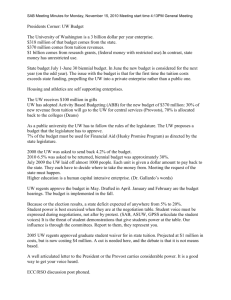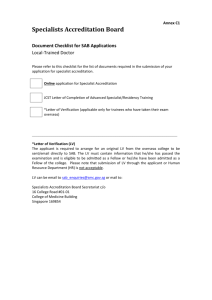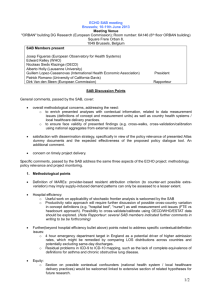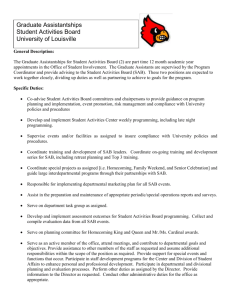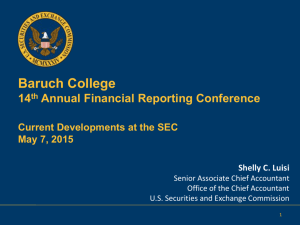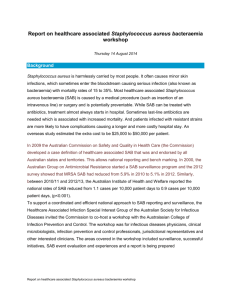Revenue Recognition
advertisement
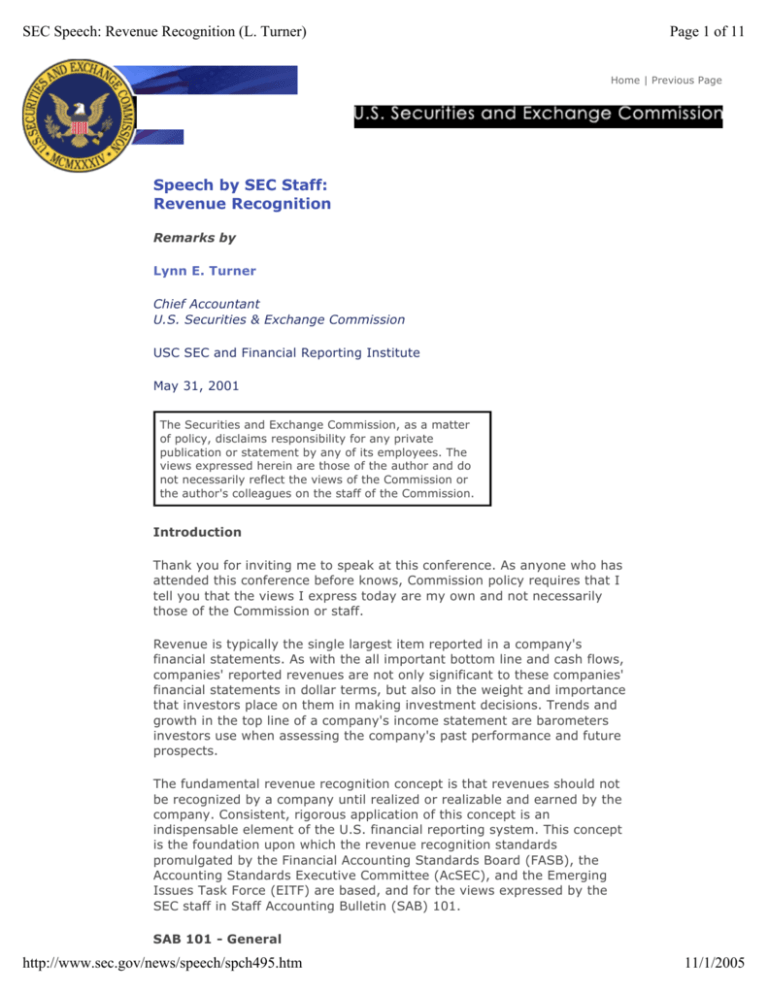
SEC Speech: Revenue Recognition (L. Turner) Page 1 of 11 Home | Previous Page Speech by SEC Staff: Revenue Recognition Remarks by Lynn E. Turner Chief Accountant U.S. Securities & Exchange Commission USC SEC and Financial Reporting Institute May 31, 2001 The Securities and Exchange Commission, as a matter of policy, disclaims responsibility for any private publication or statement by any of its employees. The views expressed herein are those of the author and do not necessarily reflect the views of the Commission or the author's colleagues on the staff of the Commission. Introduction Thank you for inviting me to speak at this conference. As anyone who has attended this conference before knows, Commission policy requires that I tell you that the views I express today are my own and not necessarily those of the Commission or staff. Revenue is typically the single largest item reported in a company's financial statements. As with the all important bottom line and cash flows, companies' reported revenues are not only significant to these companies' financial statements in dollar terms, but also in the weight and importance that investors place on them in making investment decisions. Trends and growth in the top line of a company's income statement are barometers investors use when assessing the company's past performance and future prospects. The fundamental revenue recognition concept is that revenues should not be recognized by a company until realized or realizable and earned by the company. Consistent, rigorous application of this concept is an indispensable element of the U.S. financial reporting system. This concept is the foundation upon which the revenue recognition standards promulgated by the Financial Accounting Standards Board (FASB), the Accounting Standards Executive Committee (AcSEC), and the Emerging Issues Task Force (EITF) are based, and for the views expressed by the SEC staff in Staff Accounting Bulletin (SAB) 101. SAB 101 - General http://www.sec.gov/news/speech/spch495.htm 11/1/2005 SEC Speech: Revenue Recognition (L. Turner) Page 2 of 11 We issued SAB 101 in December 1999. As amended, SAB 101 requires that any accounting changes made in response to the SAB be implemented no later than the fourth quarter of fiscal years beginning after December 15, 1999. For calendar year-end companies, SAB 101 was implemented during the fourth quarter of 2000. SAB 101 is not a rule or interpretation of the Commission, but rather represents the interpretations and practices followed by the Division of Corporation Finance and the Office of the Chief Accountant in administering the disclosure requirements of the Federal securities laws. Many have asked why we issued SAB 101. The answer to this question is very simple: Revenue recognition is an issue that surfaces in a significant number of the Commission's enforcement cases and is the largest single issue involved in restatements of financial statements. For example, a March 1999 report entitled Fraudulent Financial Reporting: 1987-1997 An Analysis of U.S. Public Companies, sponsored by the Committee of Sponsoring Organizations (COSO) of the Treadway Commission (the COSO Report), indicated that over half of financial reporting frauds in the study involved the overstatement of revenue. Recent enforcement cases, including those involving Sunbeam, which I'll touch on later, Microstrategy, and Livent, just add to the long list of enforcement actions alleging improper revenue recognition. Based on research performed by my office, restatements for revenue recognition also result in larger drops in market capitalization than any other type of restatements. Furthermore, the issuance of SAB 101 was part of an extensive, coordinated effort to combat abusive earnings management practices, which were first highlighted in a speech by former SEC Chairman Arthur Levitt in September 1998. The authoritative accounting literature on revenue recognition includes both broad conceptual discussions as well as certain industry-specific guidance issued by the FASB and its predecessors, AcSEC, and the EITF. Accordingly, in SAB 101, the staff provided a compendium of existing generally accepted accounting principles (GAAP) on revenue recognition. The 52 footnotes in the SAB provide an excellent frame of reference to the various original publications from which the guidance in the SAB are drawn. SAB 101 describes a basic framework for analyzing revenue recognition by focusing on four bedrock principles established in GAAP. Those principles state that revenue generally is realized or realizable and earned when all of the following criteria are met: 1. Persuasive evidence of an arrangement exists, 2. Delivery has occurred or services have been rendered, 3. The seller's price to the buyer is fixed or determinable, and, 4. Collectibility is reasonably assured. The general framework and foundation for SAB 101 could not be simpler - it is based on the common sense notion that revenue on a sale should not be recognized until the seller has fulfilled its obligations to the buyer under the sale arrangement. A simple example of this is bill and hold sales transactions. SAB 101 merely extracted and codified, word for word, the criteria set forth in 1986 in http://www.sec.gov/news/speech/spch495.htm 11/1/2005 SEC Speech: Revenue Recognition (L. Turner) Page 3 of 11 Accounting and Auditing Enforcement Release (AAER) No. 108 that must be met in order for a company to recognize revenue on a product sale prior to delivery of that product to the customer. Nothing new was presented in SAB 101 with respect to bill and hold transactions that was not previously spelled-out in various Commission enforcement cases (enforcement cases related to this issue are further described in AAER Nos. 108, 817, and 971, and Litigation Release No. 15093). SAB 101 reiterates and reinforces the staff's view that ALL of the bill and hold criteria must be met in order to recognize revenue prior to shipment/delivery - there is nothing new or novel in this concept. SAB 101 Implementation Watching and evaluating the effects of the implementation of SAB 101 has been very interesting. Despite all of its fanfare, less than 2 in 100 registrants reported in the calendar third quarter of 2000 that they had made or expected, at that time, to make an accounting change under SAB 101. In addition, 6 out of 100 registrants indicated that they were evaluating SAB 101 at that time and were not sure of the impact SAB 101 would have, if any. That left 92 out of every 100 companies that were not impacted by SAB 101 according to their third quarter disclosures. The staff recently completed a review of the disclosures in annual filings of companies that were required to implement SAB 101 in the fourth quarter of 2000. Based on such review, we found that approximately 4 in 100 companies said they made an accounting change to comply with the accounting literature discussed in SAB 101. Specifically, the staff searched the annual SEC filings on EDGAR of over 7,000 registrants that were required to implement SAB 101 as of December 31, 2000 and found only 291 registrants that changed their revenue recognition policy. Of the companies that made an accounting change, 207, or approximately 71% of these companies, recorded a charge for the cumulative effect of a change in accounting principle, with the average after-tax charge for those companies approximating $14 million, or 0.9% of average 2000 revenues and 7.4% of average 2000 pretax income. Of the remaining 84, or 29%, approximately 20% reported a change in accounting policy for revenue recognition that was expected to have a material effect on the registrants' results of operations only on a prospective basis. For example, some registrants in the telecommunications industry reported that they would be adopting a policy of deferring fees associated with the activation or initiation of certain telecommunications services, while deferring an equal amount of direct, incremental costs. Because an equal amount of revenues and expenses are deferred under such policy, there was no cumulative effect from the change in accounting policy to comply with SAB 101. However, the timing of recording certain revenues and expenses for these companies will be impacted on a prospective basis. The remaining 9% of the companies that made an accounting change retroactively changed certain income statement presentation or classifications. For example, many of these companies changed their policy to present revenues and expenses on a net rather than gross basis. http://www.sec.gov/news/speech/spch495.htm 11/1/2005 SEC Speech: Revenue Recognition (L. Turner) Page 4 of 11 The primary reasons for changes in companies' revenue recognition policies to comply with the accounting principles discussed in SAB 101, as disclosed by these companies, were as follows: ? ? ? ? ? ? Deferral of various up-front, or prepaid, fees for which no separate earnings process had been completed in exchange for the up-front, or prepaid, fee; Deferral of revenue until certain non-perfunctory seller obligations were completed (such as equipment installation); Deferral of revenue on product sales until such products are delivered, and title transfers to the customer, rather than when shipped; Deferral of revenue that is contingent on the occurrence of some future event until the future event occurs (such as the achievement by a lessee of certain minimum sales thresholds); For the mining industry, deferral of revenue until the mined material is sold/shipped as opposed to when extracted (pursuant to ARB 43); Income statement classification issues (primarily gross vs. net income statement classification). Furthermore, we noted that SAB 101 primarily impacted the manufacturing industry, as approximately 43% of the companies that reported a change in accounting policy in light of SAB 101 were in the manufacturing division of the Standard Industrial Classification codes. Other industries impacted, along with the percentage of the total companies impacted, were as follows: ? ? Services, 20% Transportation, Communication, Electric, Gas, & Sanitary Services, 20% ? Finance, Insurance, & Real Estate, 10% ? Mining, 3% ? Retail Trade, 2% ? Wholesale Trade, 1% ? Other/Miscellaneous, 1% Despite this small percentage of registrants impacted by SAB 101, we are concerned that some companies knew what the impact of following the accounting guidance discussed in SAB 101 would be as of the end of the third quarter of 2000, but failed to provide a meaningful, transparent disclosure of such in their third quarter filing, as required by SAB 74 and AU Section 9410, "Adherence to Generally Accepted Accounting Principles: Auditing Interpretations of Section 410, Section 3, The Impact on an Auditor's Report of an FASB Statement Prior to the Statement's Effective http://www.sec.gov/news/speech/spch495.htm 11/1/2005 SEC Speech: Revenue Recognition (L. Turner) Page 5 of 11 Date". Investors in some of these companies received an unnecessary surprise in the annual financial statements. We also have identified certain disclosures in annual filings that do not clearly explain the impact of SAB 101, or the reason(s) why a change in accounting policy was necessary. When SAB 101 was first issued, many questioned whether the staff was actually changing the existing rules related to revenue recognition, or whether some of the views expressed in the SAB were in conformity with existing GAAP. In April 2000, shortly after SAB 101 was issued, Ron Mano, an accounting professor at Weber State University, published an article in Accounting Today. In that article, professor Mano wrote: "...[I] asked my undergraduate class at Weber State University what they thought should exist before a company recognized revenue. They came up with the following list: An actual sale of goods or services; A specified price; and, The ability to collect. It turned out to be a pretty simple exercise because it took them about three to four minutes to come up with the list. Two days later, I spoke at an Institute of Internal Auditors meeting in Salt Lake City. Since the issue fit in well with my topic, I did the same exercise with that group of professionals. They came up with the same list in about the same amount of time. Next, I went to a faculty colleague and did the same exercise. In about the same amount of time, he came up with the same list. I have conducted the exercise a few additional times with other groups but always with the same result." As you can see, the list that these accounting students came up with in a very short period of time is strikingly similar to the bedrock principles of revenue recognition which are included in SAB 101, as I previously identified. In his article, professor Mano goes on to state: "Now I ask readers of this article: Why do we need a formal SEC rule to require what several different groups took about three minutes each to develop? Could it be that there are some problems out there that relate to the recognition of revenue? It is regrettable when the SEC feels a need to promulgate, as a formal rule, that which should be totally obvious to even marginally qualified accountants...We accountants need to look at ourselves and how we have participated in or even been the architects of management fraud. I do not criticize the SEC for promulgating the obvious. However, it is regrettable that we accountants have created or participated in the situation where the SEC feels compelled to promulgate the obvious." Audit Issues Related to Revenue Recognition As previously mentioned, the COSO Report notes that over half the frauds in the study involved over-stating revenues by recording revenues prematurely or fictitiously. These results are consistent with a study published in the August 2000 report of the Panel on Audit Effectiveness (also known as the "O'Malley Report") entitled, Analysis of SEC Accounting and Auditing Enforcement Releases, which found that approximately 70% of the cases in the study involved overstatement of revenues - again, either premature revenue recognition or fictitious revenue. Given the results of these studies and the current economic environment http://www.sec.gov/news/speech/spch495.htm 11/1/2005 SEC Speech: Revenue Recognition (L. Turner) Page 6 of 11 where companies are struggling to achieve revenue forecasts, it is critical that auditors conduct adequate and appropriate audit procedures on revenues. After all, the investing public relies on the independent auditors to ensure the integrity and credibility of the numbers. Revenue Recognition at Foreign Subsidiaries For international companies with significant foreign operations, revenue recognition issues at the foreign subsidiaries come up frequently. In order to prevent these problems and ensure compliance with the authoritative accounting literature regarding revenue recognition, as well as SAB 101, it is important for these companies to implement systems of internal accounting controls over the revenue recognition cycle on a global basis. Such internal control systems, at a minimum, should include the dissemination of corporate accounting policy manuals containing policies and procedures and reasonable internal controls for revenue recognition, as well as training of global sales and accounting personnel. Tests of the effectiveness of these internal control systems should be performed by auditors on a regular basis. As is true with all internal control systems, an ounce of prevention is worth a pound of cure. Timing Does Matter - Proper Cut-off Many of the frauds in the studies I referenced involved improper revenue cut-off at the end of an accounting period. Some recent enforcement cases involving improper sales cut-off are further described in AAER Nos. 1104, Donnkenny, 1017, Sensormatic, 975, Pinnacle Micro, and 971, Laser Photonics. In one recent enforcement case (see AAER No. 1325, SEC v. Maurice B. Newman and Richard A. Gerhart), the Commission alleged that the defendants instructed the personnel of Sirena Apparel Group to hold the quarterly sales ledger open for as long as it took to achieve the company's budgeted sales estimate for the quarter. Employees of the company were taking odds on how long the quarter would have to be held open in order to achieve these results. Whoever guessed 12 days won the money! The O'Malley Report noted that the common methods for manipulating cutoff included recording revenue on shipments by backdating shipping documents and delaying the recognition of returns. It is critical that auditors conduct appropriate period-end cutoff audit procedures, even when a majority of the fieldwork is conducted at interim or preliminary dates. This is particularly important for audits of businesses that experience a high level of sales transactions or individually significant sales transactions near the end of the financial reporting period. In its report and recommendations, the O'Malley Panel recommended that "Cut-off tests should be more extensive than tests of only a few transactions before and after the close of the period. Cut-off testing often should require the auditor's physical presence at the entity's location(s) at period end." I strongly endorse the O'Malley Panel recommendation and believe it is required in order for the auditor to obtain sufficient evidential matter to perform and audit that fulfills the requirements of generally accepted auditing standards. Testing of a few transactions before and after year-end will often be insufficient to provide sufficient competent evidential matter for a reasonable basis for the auditors' report. The auditor needs to get out of the audit room when testing cut-off. For example, inventory that is received or shipped by a manufacturer has to pass through the loading dock. By asking questions of and talking to shipping and receiving http://www.sec.gov/news/speech/spch495.htm 11/1/2005 SEC Speech: Revenue Recognition (L. Turner) Page 7 of 11 personnel as well as observing the loading dock, an auditor can obtain information on unusually high levels of shipments and returns, whether inventory is being shipped to off-site storage or locations other than to the customers, backdating of shipping documents, delays in recording returns, and other valuable cut-off information. Confirming Key and Important Contract Terms In some entities, the nature of the business is such that the majority of revenues are comprised of complex, large, or non-recurring transactions evidenced by individual contracts. Auditors should read and understand the terms of these contracts, since the terms could have a significant impact on the appropriate accounting treatment for the transactions, including when the revenue is recognized. For these types of transactions, auditors should confirm directly with the customer ALL significant contract terms which could have an impact on the accounting for the contracts, such as payment terms, right-of-return and refund privileges, customer acceptance criteria, termination provisions, or bill and hold arrangements. Auditors also should confirm with the customer whether significant unfulfilled vendor obligations exist, or the existence of any oral or written agreements outside of the contract that may alter the written provisions of the contract. A common problem noted in the COSO and O'Malley reports was the existence of "side agreements" that altered the terms of a sales arrangement. Because side agreements often include unilateral cancellation, termination, or other privileges for the customer to void the transaction, they pose a significant risk to proper revenue recognition. Again, I encourage the auditor to get out of the audit room. The auditor needs to ask questions and talk to the sales and marketing executives and personnel. By doing so, an auditor can obtain information on unusually high levels of sales activity near period-end, oral or written side agreements, consignment sales arrangements, unusual payment terms, collectibility issues due to unusual sales terms, financing arrangements, and other terms and conditions that may be indicative of revenue recognition issues. Reasonable Support for Reliable Estimates FASB Statement No. 48, Revenue Recognition When Right of Return Exists, provides a list of conditions, all of which must be met in order to recognize revenue at the time of sale when a right of return exists. One of those conditions is the seller's ability to reasonably estimate the amount of future returns. When auditing a company that sells through distribution channels, the auditor needs to determine if the company receives accurate and adequate reporting from its distributors regarding inventory levels in the distribution channels and current sales levels to end users. If the company does not receive this information, the resulting lack of `visibility' into the sales channel may cause an inability to reasonably estimate the amount of future returns. Both Statement 48 and SAB 101 list factors that may impair the ability to make a reasonable and reliable estimate of returns. I encourage auditors to revisit and familiarize themselves with these factors, and if necessary, make adjustments to their audit procedures. Transparent Disclosure of Relevant Trends The Sunbeam case (AAER No. 1393) highlights many of these issues, including bill and hold and channel stuffing abuses, among others, and http://www.sec.gov/news/speech/spch495.htm 11/1/2005 SEC Speech: Revenue Recognition (L. Turner) Page 8 of 11 sends a message to registrants and their auditors - the SEC will aggressively attack fraudulent revenue recognition practices. Recently, the Commission filed a civil injunctive action in U.S. District Court in Miami against five former officers of Sunbeam and the former engagement partner on the Arthur Andersen LLP audits of the company's financial statements (see AAER No. 1395). The Commission's complaint alleges, amongst other allegations, that in 1997, Sunbeam failed to disclose that it offered discounts and other inducements to customers to sell merchandise immediately that otherwise would have been sold in later periods, which threatened to depress Sunbeam's future results of operations. SAB 101 notes that disclosure in MD&A is required of shipments of product at the end of a reporting period that significantly reduce customer backlog and that reasonably might be expected to result in lower shipments and revenue in the next period. MD&A disclosures also are required of the impact of granting extended payment terms to customers that will result in a longer collection period for accounts receivable and, thus, slower cash inflows from operations, ultimately impacting a registrant's liquidity and capital resources. Vendorprovided financing with extended payment terms, especially those beyond normal and customary sales terms, are a prime example of the types of transactions the SAB discusses. The granting of extended or abnormal payment terms may, in fact, be a form of vendor financing, which may raise questions as to whether the substance of the transaction is that of a consignment. SAB 101 discusses certain characteristics of a sales arrangement that may indicate that the arrangement is a financing or consignment sale, thus precluding revenue recognition even if title to the product has passed to the buyer. Recent press articles have noted the increased use, by many well-known, established companies, of vendor financing arrangements. It is important for registrants and their auditors to be cognizant of the revenue recognition issues associated with these arrangements. The AICPA has provided excellent guidance on auditing revenues. Two Practice Alerts have been issued. In early 1999, the AICPA issued the document entitled Audit Issues in Revenue Recognition. I understand they are also in the process of finalizing guidance on auditing revenue transactions in the high technology manufacturing and computer software industries. I encourage auditors to review the AICPA guidance and consider them in determining their audit procedures. Let me emphasize - cut-off testing, confirmations, understanding sales terms and arrangements, assessing an entity's ability to estimate returns all these are not new methods of auditing revenues. This is textbook auditing - or, I suppose, one may even call it "Auditing Revenues 101". If you have not done these procedures, you have not done an audit and you are not in a position to issue an opinion on the financial statements. Cross-payment and Other Complex Customer Arrangements Companies are increasingly entering into complex strategic alliances, joint ventures, cross licensing and cross ownership agreements. These arrangements often involve two parties, each providing goods or services to each other, and may also involve the issuance of equity from one party to the other. These arrangements are commonly documented in multiple agreements that are negotiated and entered into contemporaneously. As such, the agreements are complex, and it may be difficult, if not impossible http://www.sec.gov/news/speech/spch495.htm 11/1/2005 SEC Speech: Revenue Recognition (L. Turner) Page 9 of 11 to distinguish and reliably measure the fair values of the separate elements of the contracts. A simple example of this is a company that issues warrants to a customer at the same time the company and customer enter into a supply arrangement for the company's goods or services. These arrangements have become common recently. In some instances, the warrants will only become exercisable if the customer makes a certain level of purchases. In others, the warrants are fully vested when issued, but the customer contractually commits to purchase some amount of goods or services from the issuer. The staff is concerned when it appears Company A has taken $1 million out of its left pocket only to receive that $1 million back in its right pocket, and wants to record the $1 million received in revenue. For example, assume that Company A pays Company X $1 million to enter into the purchase and supply arrangement under which Company A agrees to supply a product to Company X and Company X agrees to purchase a specified minimum volume of product from Company A. Company A gets the $1 million that it gave Company X back through Company X's guaranteed product purchases. The staff questions how these types of "round-trip" arrangements result in revenue, and whether, in substance, they are sham transactions engineered solely to inflate the revenue line in the income statement Companies and auditors must carefully evaluate the substance of these arrangements to determine the proper accounting, even in instances where the accounting literature does not specifically address the accounting for a transaction. Statement on Auditing Standards No. 69 recognizes this, noting that: "...there sometimes are no established accounting principles for reporting a specific transaction or event. In those instances, it might be possible to report the event or transaction on the basis of its substance by selecting an accounting principle to an analogous transaction or event." Guidance from the EITF exists for some of these situations as well as other types of revenue generating transactions, in Issues 96-18, 00-14, and 0025. The concepts set forth in those EITF consensuses reflect the fact that the substance of some of these arrangements is that the customer is purchasing equity from the company, in addition to goods or services. Thus, the fair value of the equity issued should be subtracted from the cash received in determining how much revenue to record. Cash proceeds from the sale of equity instruments should not be reported in the income statement, even if the sale of equity is to a customer. Although these concepts are not complex, companies have too often recorded these transactions in a way that inappropriately inflates revenues, attributing the cost of the equity instrument to "sales and marketing expense," rather than reducing revenue to reflect the equity issued. To illustrate a more complex example, a company may simultaneously negotiate and enter into agreements that provide for: ? ? The purchase by the counterparty of services from the company over several years with guaranteed minimums each year, An agreement by the counterparty not to compete with the company http://www.sec.gov/news/speech/spch495.htm 11/1/2005 SEC Speech: Revenue Recognition (L. Turner) Page 10 of 11 in certain lines of business for a period of time, ? ? ? The purchase by the company of a minimum amount of advertising from the counterparty over several years, Each party to have access to the other party's membership list for the purpose of sending targeted advertisements, and An agreement by the counterparty to assist the company in marketing its services to other's in the counterparty's industry. In complex situations like this, the company and its auditor should consider whether it is appropriate to report the related cash flows, revenues and costs on a gross or net basis. The EITF, in Issue 00-25, has recently indicated that in order to report these types of arrangements on a gross basis, the company must receive from its customer a separately identifiable benefit that the company could have obtained from a third party, and there must be sufficient, competent and verifiable evidence of the fair value of the benefit received. When an entity would not have entered into one of the separate contracts without all the contracts being negotiated and agreed to as a "package", it will often be difficult to identify a separable benefit being received and to establish reliable and verifiable fair values for each element of the arrangement. In those instances, the facts and circumstances will often dictate that the cash inflows and outflows be reported as a net revenue or cost amount, in the appropriate periods. Registrants that receive equity instruments in these transactions are required by EITF Issue No. 00-8 to disclose, in each period's financial statements, the amount of gross operating revenue recognized as a result of nonmonetary transactions addressed by the consensus. If revenue recognized or to be recognized is materially attributable to equity instruments received by a registrant and measured prior to rendering the services, disclosure about actual or possible changes in the value of the equity instruments may be material to an investor's assessment of the registrant's results of operations and liquidity. I strongly encourage registrants to consider discussing highly unusual and complex transactions with the staff on a pre-filing basis. Conclusion Let me close by coming full circle to where I began today. That is, in recent years, investors have lost tens of billions of their savings, that they worked hard to earn, as a result of financial fraud involving improper revenue recognition. And at some point in time, investors are going to lose more than their money, they are going to lose their trust in the numbers and the system and people who produce and audit them. We cannot, and shall not let that happen. I remember a song the Nitty Gritty Dirt Band did that was titled "Will the Circle be Unbroken?" Well I think it is time to get down into the nitty gritty of revenue recognition today and break this circle of problems that have tainted the many fine corporate citizens and auditors who play by the book and get the job done well. It is time we make sure revenue, like a fine wine, is not booked before its time. http://www.sec.gov/news/speech/spch495.htm 11/1/2005 SEC Speech: Revenue Recognition (L. Turner) Page 11 of 11 I ask that everyone associated globally with high quality financial reporting and disclosure be ever-vigilant in our number one duty, investor protection. All of us associated with the "Numbers" provided to investors must work together to ensure their integrity and credibility is impeccable. And the chief financial officers, controllers and audit partners who are responsible for the amounts reported as revenues, must realize the "buck" stops with you. You are the individuals who investors count on and trust. Let's make sure that trust remains well placed and on a solid foundation, not on the slippery road towards a quagmire. Thank you. http://www.sec.gov/news/speech/spch495.htm Home | Previous Page http://www.sec.gov/news/speech/spch495.htm Modified: 06/01/2001 11/1/2005

